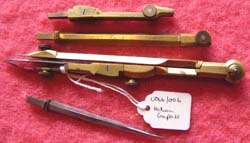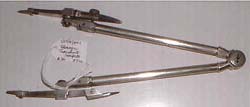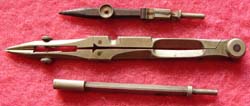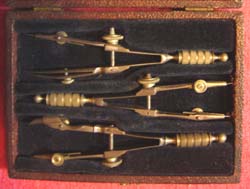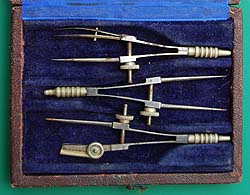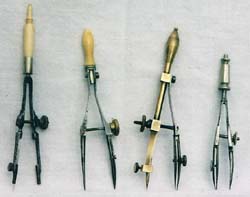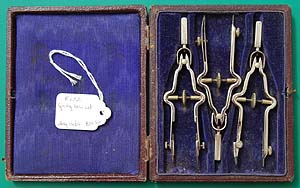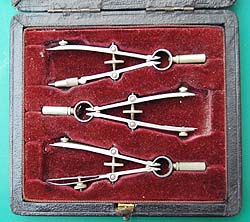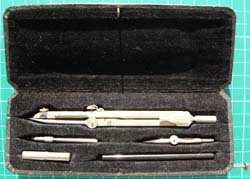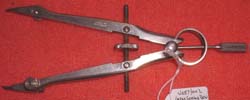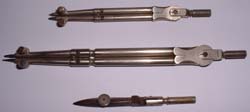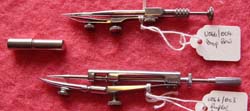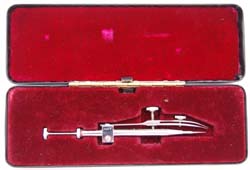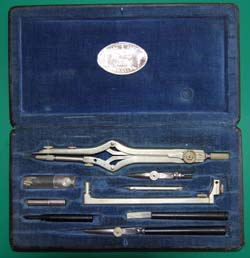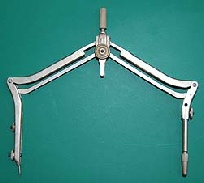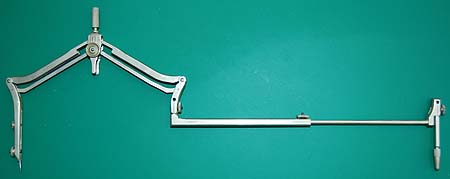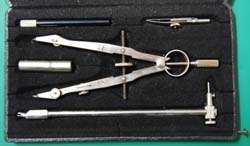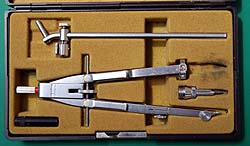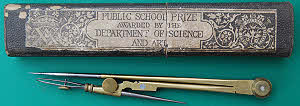












Compasses are amongst the oldest instruments and are found in every set of drawing instruments. There is a very wide variety, which I have tried to illustrate here. Others may be found in the Major Makers pages of this site.

English, brass, long joint head compass from the late eighteenth century set in a fishskin case shown on the Early Sets page. It has divider, pen, pencil and wheel pen inserts, clamped in place with a wing screw.
Italian brass compass from the mid nineteenth century. It has divider, pencil and pen inserts and an extension bar. The particular form of long joint head, the shape of the finger recess, and the shaping around the socket are all characteristically Italian.
A typical compass half set dating from about 1900. The main metal is electrum. It is double jointed with type B' needle points. It has pen, pencil and divider inserts and a lengthening bar and is a typical, British, sector headed compass.
Telescopic turnabout compass, British made, in electrum. This was an alternative to the usual compass 'half set' and could be used for all the same functions. The legs are tubular and extend. It is fitted with needle points and has a sector head. They are now fairly rare.
Foreign made electrum compass in the English style, typical of instruments found in cheaper student sets in the early twentieth century. The pencil insert is missing.
A pair of electrum bow compasses from a Halden set, circa 1900. These are unjointed and would have been nearly the cheapest, Halden made bows available at that time as they have plain points. They are about 3 inches long.
A pair of electrum bow compasses from a Harling set, circa 1900. These are double jointed and have type B points and are therefore high quality instruments.
A Cary turnabout bow compass, a type they often included in their sets instead of a pair of bow compasses. It is made of electrum and dates from circa 1900.
An Ecobra turnabout compass with self centring handle. Probably 1950s/1960s date
A set of three English made spring bows with ordinary needle points in a morocco covered case. Maker unknown. Date circa 1900.
Another set of three spring bows, again unsigned but English, in a rather distressed morocco covered case. As the hinge was missing I have used a piece of blue ribbon to act as a hinge. With plain points and simpler handles these would have been significantly cheaper than the set above.
A selection of unusual spring bows. The first is French and of quite high quality with its ivory handle and needle points. The second is probably Swiss or German, nineteenth century. The third is probably mid-19th century German, whilst the last is nineteenth century English or possibly Swiss (indicated by the curved point).
An ivory handled, single leaf, spring bow of the type often found in French sets about 1900.
An unusual set of spring bows of the ‘C’ spring type. The case is of British manufacture but, thanks to Brad Letney, I now know that the spring bows were made by Schoenner in Germany. They probably were made in the 1920s or 1930s.
Set of spring bows by MDS, London of the ‘C’ spring type made mid-20th century.
MDS were founded in 1920 as the Miscellaneous Disposals Syndicate Ltd, dealing in government surplus items. Ca. 1940 they were renamed the Manufacturers & Distributors Syndicate Ltd. Their address was 41 St James Gardens, Holland Park, London W11 and they had a factory at Empire Works, London Road, Horley.
Mars Telescopic compass, made in Bavaria.
A large (six inch) spring bow, made in Germany, of the type that became popular in the 1960s.
Riefler round system compasses. Typical of the pattern made by Riefler with minor variations for over 80 years.
Drop bow compasses. The upper is unsigned but probably by Harling. The lower is by Riefler. Drop bow compasses were also referred to as rotating compasses or sometimes, incorrectly, as pump compasses.
Haff 94 HE drop bow compass and case. The 4” long drop bow compass is ‘stainless’ and dates from the late twentieth century.
Staedtler Mars 553 57 Superbow Pen Drop Bow compass made in Nurnberg, Germany. It is fitted for use with Rotring type pens and also has a screw in pencil insert. It is complete with blue/transparent plastic box.
Original Lotter 201A “Parallel” compass set. The compass is made of electrum and steel and has pen, pencil and divider inserts as well as a telescopic extension bar. The parallel action ensures that the points remain perpendicular to the paper whatever the opening. The pictures below show the compass partially open and with its extension bar fitted and fully extended. The maximum radius arc that can be drawn is 13 inches. The compass can be locked in any position by the knurled screw at the head. Also included in the set are a cross joint ruling pen, a pen handle for use with the pen insert, a screwdriver, a tube of leads, and a tube of spare parts. It dates from the mid-1950s.
Kaufmann 2001 Universal Giant Bow compass. It dates from ca.1960. It features double knee joints, pen and pencil lead inserts and an extension bar that fits into the point leg. There are also a pen handle and a lead box. These could accomplish all of the functions of the earlier style sets of drawing instruments.
Rotring 531 146 compass made of brass and matt chrome plated. This compass is a development of the universal giant bow type , adapted to take a Rotring tubular nib pen in place of the usual pen insert. It has a special pencil lead holder that screws into the same fitting. This is the Riefler pattern of quick set compass. Rotring also sold a quick set large spring bow of the Haff pattern, which can be seen on the ‘later sets’ page.
Compass made by Aston & Mander for the Air Ministry dated 1942.
Compass set awarded as a public school prize by the Department of Science and Art, made by T Grew of Plaistow, Essex. The reversible pen and divider point fits into the pencil holder. There is a second of these in the case. Victorian.




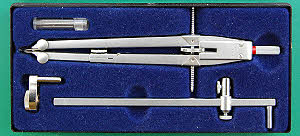
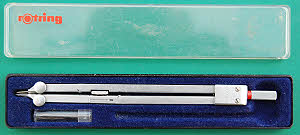

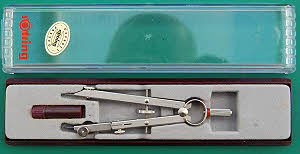
Rotring compass with centre adjusting screw, extension bar, and a fitting for taking Rotring pens
Rotring compass. The space is for an extension bar that was an optional extra. It was also possible to buy an attachment for taking Rotring pens that could be fitted in place of the pencil insert.
Rotring drop bow compass with pencil insert and one for taking Rotring pens.
Rotring spring bow with detachable pencil insert. This and the three previous instruments probably date from the 1970s

An electrum turnabout bow compass signed ‘Brush & Drummond’, probably late 19th century. Brush & Drummond were based in Melbourne Australia. It is not known whether they were makers or retailers.
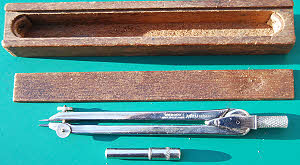
Wedoco pencil compass set made in 1942 for the Air Ministry, code 13/94.
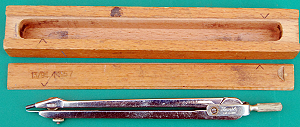
Temple pencil compass made in 1957 for the Air Ministry, code 13/94. Pencil compasses
to this requirement were made by a number of manufacturers including WEDOCO above
and Aston & Mander (also on this page), and also Thornton (two examples on Thornton
page)
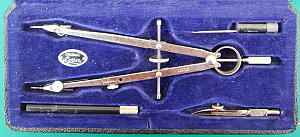
Original Lotter JR Master Bow compass dating from the 1950s/60s. The spare needle
is for use in the pencil lead insert instead of the lead to use the compass as a
divider.


Telescopic turnabout compass, British made, in electrum. This was an alternative
to the usual compass 'half set' and could be used for all the same functions. The
legs are tubular and extend.. This is a 19th century one with plain points.


Another telescopic turnabout compass, probably made by Elliott in the 19th century.
Seen from the opposite side to the one above, the slot that keeps the extension in
line and limits its travel can be seen. This compass has ordinary needle points.

Small pen bow compass, 3.1” long. It came from the same set as the telescopic compass
above as it is engraved with the same original owner’s initials. It is a design that
is so far only known in Elliott sets so was probably made by Elliott Bros.






